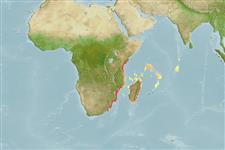Environment: milieu / climate zone / depth range / distribution range
पारिस्थितिकी
समुद्री ड़िमरसल; गहराई सीमा 35 - 75 m (Ref. 4313). Subtropical
Western Indian Ocean: Mozambique to Durban, Natal in South Africa. Reported as likely at Seychelles (Ref. 1623) but Randall and van Egmond 1994 (Ref. 10685) believe otherwise.
आकार / वज़न / Age
Maturity: Lm ? range ? - ? cm
Max length : 14.0 cm TL पुल्लिंग / अलिंग; (Ref. 4313)
Short description
पहचान कुंजी | आकृति विज्ञान | मौरफोमैटरिक्स
पृष्ठीय रीढ़ (सम्पूर्ण) : 13 - 15; पृष्ठीय सौफट रेज़ (सम्पूर्ण) : 8 - 10; गुदा कांटा: 2; ऐनल सौफट रेज़: 8 - 10. Mostly brownish, mottled in brown, pink and yellow (Ref. 4313).
Life cycle and mating behavior
Maturities | पुनरुत्पत्ति | Spawnings | Egg(s) | Fecundities | लार्वा
Eschmeyer, W.N., 1986. Scorpaenidae. p. 463-478. In M.M. Smith and P.C. Heemstra (eds.) Smiths' sea fishes. Springer-Verlag, Berlin. (Ref. 4313)
IUCN Red List Status (Ref. 130435)
Threat to humans
Harmless
Human uses
साधन
Special reports
Download XML
इंटरनेट स्रोत
Estimates based on models
Preferred temperature (Ref.
123201): 21.8 - 26.2, mean 25.3 °C (based on 16 cells).
Phylogenetic diversity index (Ref.
82804): PD
50 = 0.5625 [Uniqueness, from 0.5 = low to 2.0 = high].
Bayesian length-weight: a=0.00389 (0.00180 - 0.00842), b=3.12 (2.94 - 3.30), in cm total length, based on all LWR estimates for this body shape (Ref.
93245).
Trophic level (Ref.
69278): 3.8 ±0.7 se; based on size and trophs of closest relatives
लौटाव (Ref.
120179): ऊंचा, न्यूनतम जनसंख्या दुगनी समय अवलागत 15 महीने। (Preliminary K or Fecundity.).
Fishing Vulnerability (Ref.
59153): Low vulnerability (10 of 100).
